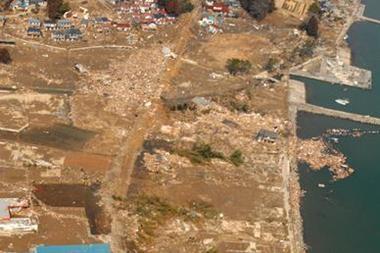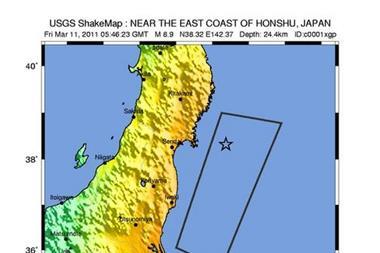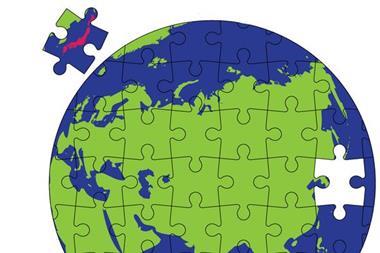What impact will the tragedy have on the insurance industry?
After the initial shock of the 11 March earthquake and resulting tsunami in Japan, a clearer picture has started to emerge about the size of the global (re)insurance industry’s exposure to the event.
On the morning of that day, a magnitude 9 earthquake struck off the coast of northern Japan, causing severe shaking across wide swathes of the country. The quake in turn triggered a three-metre-high wave that slammed into the east coast of Honshu – Japan’s main landmass – swamping Fukushima, Ibaraki, Iwate and Miyagi prefectures in particular.
Staggering losses
The event has clearly been devastating from a humanitarian perspective. The official death toll stands at 8,450, with a further 13,000 thought to be missing. And, judging by initial estimates, which range from $10bn to $35bn from various sources, total insured losses will be in line with those from last year’s Chile earthquake at best.
It is also worth noting that some of the numbers released to date, including AIR Worldwide’s $15bn-$35bn insured loss figure, exclude estimates from non-modelled events, such as tsunami and indirect business interruption.
However, international reinsurers’ share of the eventual losses will be limited because the market structure will keep a lot of the risk in the country.
Shouldering the burden
Given where the quake and tsunami hit, a large proportion of the property losses are thought to be residential rather than commercial. Those residential property policies written by traditional non-life insurers are covered by the government-backed earthquake insurance scheme, Jisai.
The scheme currently provides ¥5.5trillion ($68bn) in cover, which the government assumes and then cedes a portion out to the Japan Earthquake Reinsurance Company and the private Japanese market. Crucially, the Japanese insurers have to retain all of the risk they assume from the scheme and so cannot share the burden with reinsurers.
An exception to this is policies written by foreign insurers (which have a small market share) and co-operatives. These firms are not part of the government earthquake scheme and can buy reinsurance in the private market. Some contend there will be an agricultural portion to the losses, which could find their way to the international market.
Not as bad as it looks?
While there will undoubtedly be commercial losses - a good proportion of which could end up in the international reinsurance market - these might not be as bad as the news images suggest.
One source, for example, mentioned that according to figures from the Japanese Tariff Association, the combined probable maximum loss for cargo in ports in the two hardest-hit prefectures was ¥6.4bn ($79m).
The source also pointed out that fishing vessels are typically covered by a pool arrangement that is not insured in the private market.
Speaking at the MultaQa Qatar conference on 14 March, outgoing Aon Benfield UK chairman Charlie Cantlay said that TV images could lead the industry to believe it faced “an absolute monster of a loss”, but added: “The truth is, we simply don’t know at this point.”
Endurance chief executive David Cash said that while one or two catastrophe firms may find themselves over-exposed to Japan and have to rethink their strategy, the effect on the wider global (re)insurance industry would be more subdued.
“I believe this provides some sort of support for the global reinsurance market, but it is not a market-changing experience,” he said. “The fact that this event is plausible and doesn’t cause us to think our models were defective is important. It allows the reinsurance market collectively to be a little more stable than people imagined.”
Details still emerging
That is not to say that (re)insurers can breathe a sigh of relief: much uncertainty remains. The early loss estimate ranges are wide, and some have yet to factor in tsunami implications. AIR Worldwide said in its loss estimate that the tsunami was the “main event” and it plans to use Japan Meteorological Agency tsunami wave data and other information as it becomes available to estimate the tsunami loss and issue a combined shake, fire-following and tsunami loss estimate.
There are many other sources of potential loss and complication that are still emerging, such as business interruption and the environmental liability impact of the explosions at the Fukushima Daiichi nuclear power station.
Then there is the potential for aftershocks. Mistui Sumitomo at Lloyd’s, a division of Japan’s largest insurer MS&AD Group, warned on 16 March that the situation in Japan remained volatile and there was a risk of further significant aftershocks.
Enough to harden the market?
Understandably, many companies are shying away from putting even a rough number on losses. While some tentative initial estimates have been released – ACE has put its losses at between $200m and $250m – most company statements have said that it is too early to say.
Though some are sceptical that the Japan loss alone would be enough to harden the global reinsurance market, some believe the psychological impact of the event, coming as it does after the a busy 2010 catastrophe year and a string of losses already in 2011, will hit harder than the insured losses.
As one source said: “I would be surprised if there was no effect from everything that has gone on.”
Hosted by comedian and actor Tom Allen, 34 Gold, 23 Silver and 22 Bronze awards were handed out across an amazing 34 categories recognising brilliance and innovation right across the breadth of UK general insurance.













































